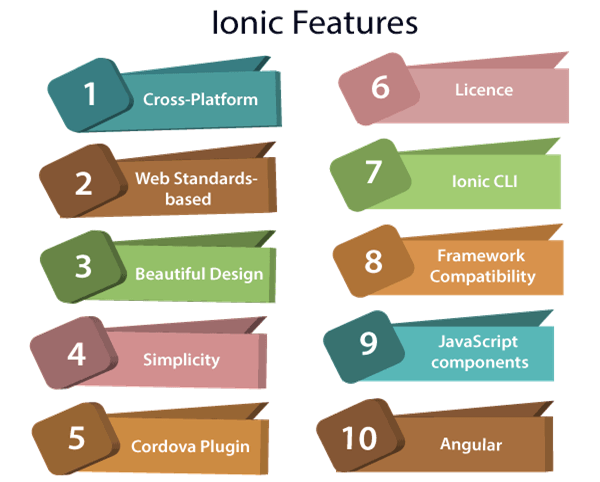Ionic Framework FeaturesIonic framework is an open-source AngularJS based framework that allows a developer to use a combination of several web technologies such as HTML5, CSS, and JavaScript. With the help of these technologies, the mobile app developer can design a creative user interface and introduce user-friendly features for their targeted audience. Some of the most important features of the Ionic framework are as follows: 
Cross-platform The app builds on the Ionic framework can deploy across multiple platforms, such as Android, native iOS, Desktop, and the web as a progressive web app and all with one codebase. Thus, Ionic apps can write once and run everywhere. Web Standards-based Ionic framework is built on reliable, standard web technologies, such as HTML, CSS, and JavaScript, using modern web APIs (like Custom Elements and Shadow DOM). Due to this, Ionic components have a stable API, which allows running Ionic app on multiple platforms. Beautiful Design The Ionic framework allows us to build a clean, simple, and functional application. It is designed to work and display beautifully across multiple platforms. The Ionic application contains pre-designed components, typography, interactive paradigms, and a gorgeous base theme. Simplicity The Ionic framework built with simplicity, easy to learn, and can be accessible to anyone with web development skills. Cordova Plugin It offers the API which needed for using native device functions with JavaScript code. License Ionic framework is a free and open-source project which released under the MIT license. It means we can use it in personal or commercial projects for free. Ionic CLI The Ionic CLI, or Command Line Interface, is a tool that provides several helpful commands to Ionic developers. It is a command which is used for starting, building, running, and emulating Ionic applications. Framework Compatibility The past releases of Ionic were tightly coupled to Angular. But the recent version of Ionic, i.e., v4 was re-engineered to work as a standalone web component library, with integration for the latest JavaScript frameworks. We can also use it in most of the front-end framework, such as React.js and Vue.js. JavaScript Components It extends the CSS components with JavaScript functionalities to cover all mobile elements which cannot be done only with HTML and CSS. Angular Angular is responsible for making the Ionic great. While the core components work as a standalone web component library, the angular package makes the integration with angular ecosystem a breeze. The angular package includes all the functionality that angular developers would expect and integrates with Angular core libraries. Ionic framework V4+ featuresIonic Framework V4 comes with a major advancement in the underlying technology and capabilities of the project. It has a great focus on performance, compatibility, and overall extensibility. The new features introduced in Ionic 4 are as follows. Web Components One of the biggest changes Ionic V4 has brought is that they moved to be web components for each component. Web components are a set of web platform APIs. It allows the developer to create customized and reusable HTML tags to use in web pages and web apps. Web components make a significant improvement in the start-up and loading times, and highly essential for building high performing web apps. It is based on four main specifications: Custom elements, HTML imports, HTML Template, and Shadow DOM. Capacitor It is cross-platform API and a code execution layer which makes it easy to call Native SDKs from web code. It also writes the custom Native plugins that your app might need. It also enables the developer to write one app and deploy it to the app stores and the mobile web. Stencil It is a new web component compiler created by the ionic team to build the standards which are compliant with the web servers. It also uses the additional API, such as TypeScript, Virtual DOM, JSX, and async, which are best suited for PWA. Ion-Backdrop They are full-screen components which overlay other components. They are placed on the top of the other content and used to dismiss the other component. Ion-picker It displays a row of buttons and columns on the top of the application content, and the bottom of the viewport. Ion-Ripple Effect The ripple effect is a component which adds the Material Design ink ripple interaction effect. It is built to be efficient, non-invasive, and usable without adding any extra DOM to the elements. It works without degrades JavaScript for CSS-Only implementation. Ion-Route It takes a component, and render it when the Browser URL matches with the URL properties. Ion-Searchbar It consists of a text field which is used to search through a collection. The Ionic team has added nine different search bar styles in the v4. Color changes The Ionic team have changed the default color and added some new default color for the Ionic framework. CSS Variables It is the highlighting features of the Ionic framework. It will modify the entire look and feel of the app by making the tiny changes in some variables without using the build tools. Lazy Loading It is a design pattern in the Ionic framework used to distinguish the initialization of components until it is needed. It increases performance and decreases the application load time by dividing it into multiple bundles and loading the app on demand. Changelogs in Native 5 It is basically stuffed with three bundles, which are Angular providers, ES6 modules, and AngularJS support. The ES6 and bundle releases feature static classes for plugins.
Next TopicIonic History
|
 For Videos Join Our Youtube Channel: Join Now
For Videos Join Our Youtube Channel: Join Now
Feedback
- Send your Feedback to [email protected]
Help Others, Please Share










